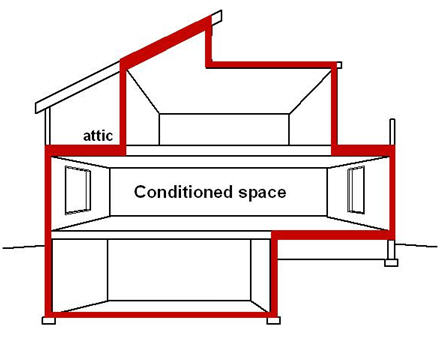What is a Building Envelope?

Put simply, your home’s building envelope is the divide between the inside and outside of the building. Its primary purpose is to improve the interior’s climate control. The exterior system includes windows, doors, the roof, floor, and even your foundation and insulation. If you’re experiencing irregular temperatures, poor indoor air quality, and air leakage, your home may be suffering from a poorly cared-for building envelope.
Efficient climate control not only increases the energy efficiency of your home but also reduces potential health risks. Updated insulation and air sealing help keep heat inside during the winter while preventing heat from entering during the summer, contributing significantly to reducing the stress put on your HVAC system. While the primary function of the building envelope is to maintain a climate-controlled interior, it also supports the strength of the house’s structure to improve how well it handles external forces and weight.
Insulation’s Common Interest: Heat Transfer
Insulation is one of the main factors in maintaining a strong and efficient building envelope, primarily because they share a common goal: climate control and temperature regulation. You may already be familiar with the material in your attic, but did you know insulation is actually installed all throughout the structure? Blown-in, batts, and spray foam material are applied within your walls, floors, between ceiling joists, and throughout your basement and crawl spaces. The Department of Energy has a breakdown of guidelines and basic requirements for insulating a home, although the specific needs and codes will vary depending on where you live.
Insulation material is designed to reduce the rate at which heat enters and exits a building, which is known as heat transfer. This rate can be measured using the material’s R-value, or resistance value, which determines how effective the insulation slows the transfer of heat throughout the structure. The R-value depends on the material (fiberglass, cellulose, spray foam, etc.) and the type (batt, blown-in, etc.) For example, blown-in fiberglass has an average R-value of 2.7 per inch but fiberglass batts can have an R-value between 3.1 and 3.7. To learn more about R-value, check out Koala Insulation’s explanation in How Insulation Works.
The material doesn’t just work to keep outside temperatures from affecting the interior. It’s installed throughout the house because it also regulates temperature between the different rooms and floors. If you have one room or even a side of the house that’s too hot or cold in comparison to the rest of your home, deteriorated insulation may be the culprit. While some insulation materials can have a lifespan of 15 years, damage from things like pests and moisture can increase the rate of deterioration.
How Does Insulation Support the Building Envelope?
Properly installed insulation that has effective coverage throughout the house significantly supports your home’s building envelope. The two work together to improve temperature regulation, maintaining the interior climate while reducing the influence of outdoor temperatures. Many materials also contribute to the safety and integrity of the building envelope as well. Most types of insulation have natural properties or are chemically treated to resist moisture, fire, and pests. Mold growth, bacteria, infestation, and heat damage not only damage the building envelope but can significantly increase the rate of deterioration for the material and structure.
Additionally, other materials even have the ability to support the structural integrity of your structure. For example, closed-cell spray foam is rigid when installed in the walls and ceiling, providing additional strength to the joists and surfaces it’s applied to. It also has an average R-value of 6.9 per inch, which is one of the highest values out of the common materials. This means less needs to be applied to resist the transfer of heat.
Learn More with Koala Insulation’s Industry Leaders
Learning something new about your home can often lead to quality of life improvements and cost reductions. When it comes to your building envelope and improved insulation, updated material and improved coverage can increase your energy efficiency, indoor air quality, and more. The building envelope directly contributes to a climate-controlled environment and the strength of your home; as such, keeping it well insulated is crucial to maintaining the integrity of your home’s structure and safety.
Your local industry leaders at Koala Insulation of Central Atlanta offer free evaluations in order to determine the current condition of your home. While our primary focus is increased comfort and safety while decreasing your monthly costs, we also want to provide the opportunity for you and your household to learn more about your home and its needs. Contact your us at (404) 994-1287 or visit our website at Koala Insulation of Central Atlanta to schedule a free evaluation.
Find Your Location


Get a quote


